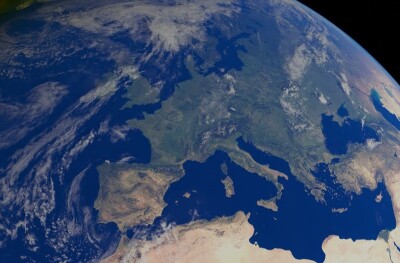The creation of a UAS traffic management (UTM) system is truly one of the most exciting developments for the industry. NASA has defined the term in technical detail, but suffice to say that their goal is to put together a cloud-based system that will allow drone operators to communicate with one another and fly safely by enabling them to easily see where other drones are flying. Among other things, the proposed system will help manage drone traffic and provide critical insight around weather conditions and stationary objects.
Information about the progression of this system had been sparse, but in April the technology came to the forefront as NASA announced success after flying 24 drones throughout a three-hour test, with 22 flying simultaneously at one point. It was an important milestone that is a testament to all of the people that have been involved with the NASA UTM program.
Jonathan Evans
 As someone who reads about (and sometimes even writes about) all the amazing things drones are and will be able to do, I absolutely understand the need to get everyone to focus on the present rather than an ill-defined future. But as a member of the NASA UTM and Global UTM project, you have insights around how things can and will change. What can you tell us about how technology and regulation are going to impact where things are headed for the industry?The interface of this technology with regulation is something that’s evolving, and I think we can look to some historical models to get a better understanding of how that is going to progress.Think about a four-way intersection. Four way intersections have been around long before automobiles. They’re a crossroad. People have been coming to these sorts of crossings for centuries, but let’s focus on what happens when two automobiles first came to that intersection. For the first automobiles, the only thing they had to rely on were the rules of the road that were culturally established. There was a concept of “you go first and then I go,” which could just as easily be written into some kind of law. You can see there’s this simple algorithm that’s culturally translated. It’s what set the cadence of getting through that four-way intersection.Now, introduce a stop light to that situation, and that technology sets that algorithm to a meter of some kind. It makes the flow that happens there more efficient. That can then get evolved into a series of stoplights that are all programmed to each other to optimize the flow of traffic. That regulatory concept adds texture to the four-way intersection. It fits hand-in-glove with the technology of the automobiles that are moving through it. It’s a combination of regulation and technocratic solutions to optimize the use of this common thoroughfare.We’re going through the same evolution in commercial drones. Right now, we’re at the point of having four-way intersections with no stop signs. We get that there are principles of cooperative airspace management with trusted purveyors of the airspace, but we also have a whole bunch of people who are just blasting through those figurative intersections right now who don’t know about those “rules of the road”. Things will improve, of course, and we’re working on getting to the algorithmically based stoplights. That’s really what we’re working on at UTM. We’re designing the next infrastructure and laying it out in an interoperable blueprint we can all build to. So how does a UTM system factor into this evolution? What we’re doing at NASA UTM, in addition to the technocratic blueprint, is reference design. We’re looking to be able to show a networked conduit. To stand up a prototype. I’ll make another comparison with the birth of the Internet, because I think it really works as a technological metaphor.The Internet really started as the DARPANET, a military-incubated technology. The DARPANET had a certain amount of usefulness for the military, and then it evolved to become the ARPANET, which is the first civil version of this technology. Out of the ARPANET, and through the efforts of bodies like ICANN that set a blueprint for interoperability, we get the commercial Internet we all know and use today.So I see DARPANET and ARPANET as that reference design. Those things established an infrastructure by which personal computers or institutional computers could connect information to each other. They made those first connections and had their “ah-hah” moment, which led to others realizing they could do the same thing with their smaller, faster, cheaper and increasingly ubiquitous Moore’s Law-driven personal computer. And now we carry them in our pockets, and we’re constantly connected on the infrastructure that evolved from this.I think we’re looking at a similar type of progress right now in aerial robotics and a future aerial robotics network. We have this reference design at NASA UTM, and we’re starting to show interoperable drones. We can take that and put a blueprint together, and the industry will build technology that operates along those same protocols and standards. We need to establish the http and TCP/IP for the sky, and that’s what UTM is about. Can you tell us about the conversations you’re having in these rooms with your fellow members of NASA UTM and the global UTM project? What sort of issues and problems are you talking through?Most of it is us laying out a blueprint for a technocratic system that marries elegantly to a well-regulated environment that is the global airspace. It’s about working together to continue to safely manage the airspace and how different stakeholders in the ecosystem – government stakeholders, industry stakeholders and anyone in the airspace – evolve together into a technocratic interoperability. That’s what those conversations are about. To bring us even closer to the comparison I just made, what we’re doing looks a lot like the foundation work that was done at ICANN at the beginning of the commercial Internet. So if this is about putting together a blueprint that makes sense for the industry as a whole, it seems like simply getting all of the key players together in the same room is more than half the battle. Is that a major part of this initiative?That’s exactly what it is. You can picture it like a standards body that we’ve seen in other industries, where multiple industry stakeholders come to the table. PK (Dr. Parimal Kopardekar, of NASA UTM) really deserves a lot of credit for getting all those stakeholders in the same room, and NASA is a great mantle for this important work.When you have Google and Amazon as a sort of new vanguard in the aviation constituency and then you pull in another huge base with companies like AT&T and Verizon, plus classic aviation companies like Lockheed Martin and Harris, you can get some incredible movement. All of these companies are involved in the same conversation about technocratic interoperability. How do the definitions around legal and safer operation of a drone define the approach you’re taking as you put together this blueprint?The regulators are giving us the “what”. They’re defining the rules of the road for us. They’re requiring us to make the engineering and applications meet the standard of safety that exists in aviation today, and they should. This industry’s safety record is the gold standard. We on the industry side do the “how”. We produce the engineering solutions that meet those requirements.When you want Amazon and Skyward operators to share the same airspace in Portland, so that Amazon can deliver packages and our clients can do a bridge inspection, those drones need to be able to operate safely in the same area. That’s fundamental, and codified. Meeting that requirement is a set of engineering problems that we’re solving and proving they meet that requirement to the regulator. Click here to read Part 2 of this interview.
As someone who reads about (and sometimes even writes about) all the amazing things drones are and will be able to do, I absolutely understand the need to get everyone to focus on the present rather than an ill-defined future. But as a member of the NASA UTM and Global UTM project, you have insights around how things can and will change. What can you tell us about how technology and regulation are going to impact where things are headed for the industry?The interface of this technology with regulation is something that’s evolving, and I think we can look to some historical models to get a better understanding of how that is going to progress.Think about a four-way intersection. Four way intersections have been around long before automobiles. They’re a crossroad. People have been coming to these sorts of crossings for centuries, but let’s focus on what happens when two automobiles first came to that intersection. For the first automobiles, the only thing they had to rely on were the rules of the road that were culturally established. There was a concept of “you go first and then I go,” which could just as easily be written into some kind of law. You can see there’s this simple algorithm that’s culturally translated. It’s what set the cadence of getting through that four-way intersection.Now, introduce a stop light to that situation, and that technology sets that algorithm to a meter of some kind. It makes the flow that happens there more efficient. That can then get evolved into a series of stoplights that are all programmed to each other to optimize the flow of traffic. That regulatory concept adds texture to the four-way intersection. It fits hand-in-glove with the technology of the automobiles that are moving through it. It’s a combination of regulation and technocratic solutions to optimize the use of this common thoroughfare.We’re going through the same evolution in commercial drones. Right now, we’re at the point of having four-way intersections with no stop signs. We get that there are principles of cooperative airspace management with trusted purveyors of the airspace, but we also have a whole bunch of people who are just blasting through those figurative intersections right now who don’t know about those “rules of the road”. Things will improve, of course, and we’re working on getting to the algorithmically based stoplights. That’s really what we’re working on at UTM. We’re designing the next infrastructure and laying it out in an interoperable blueprint we can all build to. So how does a UTM system factor into this evolution? What we’re doing at NASA UTM, in addition to the technocratic blueprint, is reference design. We’re looking to be able to show a networked conduit. To stand up a prototype. I’ll make another comparison with the birth of the Internet, because I think it really works as a technological metaphor.The Internet really started as the DARPANET, a military-incubated technology. The DARPANET had a certain amount of usefulness for the military, and then it evolved to become the ARPANET, which is the first civil version of this technology. Out of the ARPANET, and through the efforts of bodies like ICANN that set a blueprint for interoperability, we get the commercial Internet we all know and use today.So I see DARPANET and ARPANET as that reference design. Those things established an infrastructure by which personal computers or institutional computers could connect information to each other. They made those first connections and had their “ah-hah” moment, which led to others realizing they could do the same thing with their smaller, faster, cheaper and increasingly ubiquitous Moore’s Law-driven personal computer. And now we carry them in our pockets, and we’re constantly connected on the infrastructure that evolved from this.I think we’re looking at a similar type of progress right now in aerial robotics and a future aerial robotics network. We have this reference design at NASA UTM, and we’re starting to show interoperable drones. We can take that and put a blueprint together, and the industry will build technology that operates along those same protocols and standards. We need to establish the http and TCP/IP for the sky, and that’s what UTM is about. Can you tell us about the conversations you’re having in these rooms with your fellow members of NASA UTM and the global UTM project? What sort of issues and problems are you talking through?Most of it is us laying out a blueprint for a technocratic system that marries elegantly to a well-regulated environment that is the global airspace. It’s about working together to continue to safely manage the airspace and how different stakeholders in the ecosystem – government stakeholders, industry stakeholders and anyone in the airspace – evolve together into a technocratic interoperability. That’s what those conversations are about. To bring us even closer to the comparison I just made, what we’re doing looks a lot like the foundation work that was done at ICANN at the beginning of the commercial Internet. So if this is about putting together a blueprint that makes sense for the industry as a whole, it seems like simply getting all of the key players together in the same room is more than half the battle. Is that a major part of this initiative?That’s exactly what it is. You can picture it like a standards body that we’ve seen in other industries, where multiple industry stakeholders come to the table. PK (Dr. Parimal Kopardekar, of NASA UTM) really deserves a lot of credit for getting all those stakeholders in the same room, and NASA is a great mantle for this important work.When you have Google and Amazon as a sort of new vanguard in the aviation constituency and then you pull in another huge base with companies like AT&T and Verizon, plus classic aviation companies like Lockheed Martin and Harris, you can get some incredible movement. All of these companies are involved in the same conversation about technocratic interoperability. How do the definitions around legal and safer operation of a drone define the approach you’re taking as you put together this blueprint?The regulators are giving us the “what”. They’re defining the rules of the road for us. They’re requiring us to make the engineering and applications meet the standard of safety that exists in aviation today, and they should. This industry’s safety record is the gold standard. We on the industry side do the “how”. We produce the engineering solutions that meet those requirements.When you want Amazon and Skyward operators to share the same airspace in Portland, so that Amazon can deliver packages and our clients can do a bridge inspection, those drones need to be able to operate safely in the same area. That’s fundamental, and codified. Meeting that requirement is a set of engineering problems that we’re solving and proving they meet that requirement to the regulator. Click here to read Part 2 of this interview. 















Comments